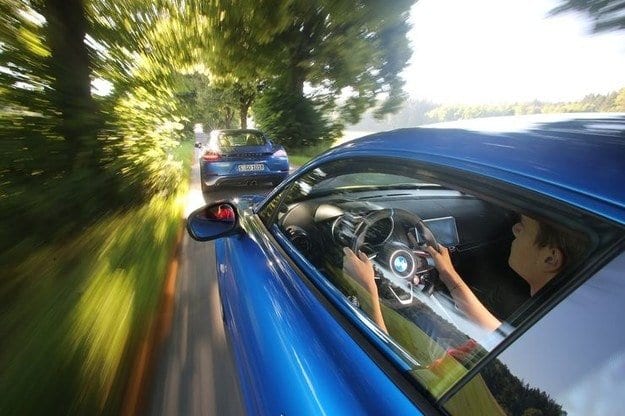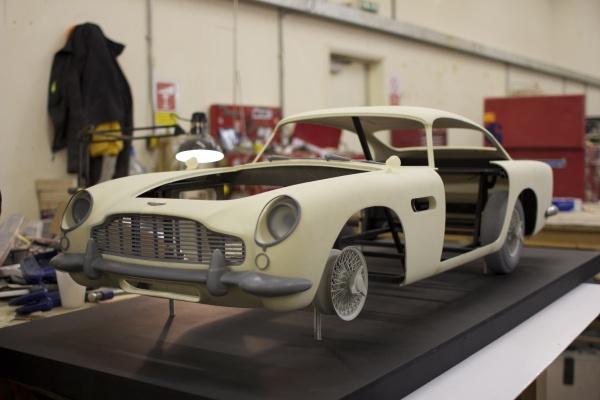
Test drive Alpine A110 vs Porsche 718 Cayman: don't be afraid to dream

Duel between two light and strong athletes with a central engine
In 2016, Porsche dared to equip the 718 Cayman with a four-cylinder turbo engine. Renault, he dared to revive Alpine. A small, light and maneuverable sports car is completely contrary to the trends of the new time.
If we have to go back to the story of the Renault Alpine, there is hardly room for anything else in these pages. This way, we will keep our nostalgic time travel and tell what is happening here and now.
We turn left, onto the sun-drenched slope of the mountain. And as if everything was served to us in a frying pan - the asphalt of the winding road is warm and dry, and it is this coating that provides excellent traction.
We need the latter. Slightly slow down, downshift and turn. The suspension on the right wheel flexes slightly, the body adjusts and the car follows a curve. Alpine transforms the road into a path to the heart and a feeling of the breath of eternity.
The latter requires an explanation. The sensation is similar to the moment the swing reaches its top dead center. A moment filled with more content, more intense and longer, in which time seems to stop. It turns out that such a moment can be experienced behind the wheel of a sports car - the main thing is that his name is Alpine. This is the moment when you reach weightless neutrality and when the driver becomes part of the physical transformation from static to dynamic friction. Then, when the forces of traction and compression mix, and when Newtonian physics becomes an all-consuming pleasure. A moment of great happiness in a small car.
Perhaps mathematicians, physicists and even engineers will ironically smile at such surges from physics to romance, especially if they participated in the creation of the Porsche 718 Cayman. Because for them, the desired effect is less than the pleasure of moving with the door forward, and more of the result. As the parameters we measured actually show.
Of course, adaptive dampers (€1428), a self-locking rear differential (€1309) and the Sport Chrono package (€2225) contribute to this, but the essence of the Cayman is what counts most. By these measurements, it outperforms the Alpine in every way, although some have only one idea. 146,1 vs. 138,5 km/h in fast lane changes. 69,7 vs 68,0 km/h in slalom. 4,8 vs. 4,9 seconds when accelerating to 100 km / h. 34 vs. 34,8 meters when stopping at 100 km / h. The same is true when measuring two cars on the scales - 1442 kg vs. 1109 kg.
333 kilograms of excess weight. The Cayman has gained a lot since its founding in 2005, when it was still something of a Porsche Alpine. A nimble and agile vehicle that made its way everywhere, overcoming even the narrowest places. With this he replaced a 911 with a Rubens-style rear end. Everyone for whom Porsche was synonymous with a sports car chose the Cayman (S), and everyone who considered the brand to be a rocket carrier was heading for the 911.
Over the years, the spirit of the times has tarnished the Cayman. He not only gained weight, but became so large that a small car could pass between his tire tracks. Which, however, doesn't really bother Porsche.
Renault clearly has a different outlook on things. You must have the courage to shove the passengers into the narrow seats. Or discard the frog to maintain a slender line. Or declare random cavities in the torso. Who argued that the growth of the auto industry was irreversible?
Without backrest adjustment
Yes, in this regard, the people at Renault Sport, responsible for the development of Alpine, did not compromise. The engineers carefully positioned everything to keep it in place. And not at all as usual for a large-scale, albeit sports car. So Alpine has a sleek, glued-and-riveted aluminum body that, in the Premiere Edition, has everything from air conditioning and infotainment to two seat panels (no backrest adjustment).
If you want to sit straight, you need to take a wrench and use it to fix the body, turning it forward one position - or take the opportunity to order adjustable seats. If you want even more luxury in general, it is better to choose a Porsche model, because it can be quite comfortably equipped - against a lot of dry steam, of course.
The fact that it will make it even heavier doesn't really matter given the fact that the Cayman seems pretty solid anyway compared to the A110. Maybe that's why the 718 firmly clings to the asphalt, moves like rails and lies on the road like a board. All analogies that sound cliché.
However, the cliché you use to describe a car that stoically follows all sorts of configurations on the track and in no case allows itself to run. Adaptive dampers, a rigid suspension and a steering system that filters out various interference, help it absorb bumps. Added to this is the chassis geometry for exceptional cornering stability. Rewind? There is no such thing. Insufficient dosage? Yes, but such a speed cannot be imagined on a regular intercity road. And to what we got only at the hippodrome.
On the way, the Cayman condescendingly encourages you to move faster, as if telling you, "You are too slow, maybe more." There, it will be difficult for you to get to the point where you not only move fast, but also feel that you are moving fast.
The two-seater model with a central motor does not rotate around the central axis, does not service, the rear remains calm or, in other words, you will not reach the moment of eternity. Instead, driving takes place while quickly covering a route without events.
Racing pilots love this type of tuning because they are always calm and fast on their purely piloted laps. Therefore, if you want to replay quick tours of your home track repeatedly, you can opt for a Porsche model.
This stability is also aided by the four-cylinder boxer engine, which prevents excessive power surges. After passing the turbo pit, the two-liter unit pulls powerfully and evenly. The trailed rear axle can sequentially absorb torque by receiving specially developed traction parts from the seven-speed PDK gearbox. However, a dual-clutch transmission fails to convey the harmony of the drive. She feels overly motivated because, even in comfort mode, she often switches two, three, and even four degrees down. And there is no need for this, because, in principle, Newton meters are always enough for a powerful intermediate acceleration. Something similar happens when you stop in front of a license plate, and when you get into it, the engine makes thunderous sounds after the transmission has shifted into second gear. At least one more unpleasant moment must pass before she can switch to a higher one again.
In this regard, the Alpine's seven-speed transmission is quieter and lets the A110 float on a wave of torque. If you pull the lever on the steering wheel in Track mode while downshifting, the dual-clutch transmission will add a well-designed intermediate throttle salute. Overall, Renault Sport has given the well-known 1,8-liter engine a poised voice that makes the 718 Cayman's boxing engine sound somewhat senselessly brutal.
Eminently unfounded
Now 252 hp For the price, they don't look particularly impressive. But when they have only 1109kg to go plus the driver, the power-to-weight ratio becomes quite impressive. A side effect is a sensationally lower consumption in the test - 7,8 vs. 9,6 l / 100 km. So Alpine became a very intelligent car. What's more, the Premier Edition is so well-equipped that the Cayman looks naked by comparison. The French model offers a three-year warranty instead of two. In fact, the folks at Renault Sport have gone to great lengths to make sure that on four not-so-wide wheels, you get both a sensible and unintelligent model that roams the corners and is made just for driving pleasure.
The latter includes sliding to the side as much as necessary. To do this, he must activate the track mode and deactivate ESP. On a steering track like the one in Boxberg, all this is enough to enter a corner with a little overspeed, wait for a moment until the body and the change in axle load lighten the rear. Without the electronics leash, it starts to turn a little and can be remarkably stabilized with low torque, and the angle can be fine-tuned using the precise feedback steering system.
It is also remarkable that even on a small road the A110 does not behave stubbornly, does not lean too much, or even particularly shy when changing dynamic loads. However, there is life in its undercarriage. The suspension works motivated all the time, analyzes the road surface, informs about traction and soothes waves on the road. The A110 creates a subjective feeling of high speed, while the Porsche model moves on corners like on rails and is always below its capacity. Of course, with its perfectionist utilitarianism, the latter clearly wins in the quality section. Even minor criteria for a sports car such as ergonomics, functionality, safety systems and multimedia contribute to this, which also provide their share of the points advantage.
Alpine's answer lies in price: as a Premier Edition, it's available for 58 euros. If the Porsche model is equipped in the same way, it will cost at least 000 euros. That's enough for a bit of a sensation - albeit by a small margin, the A67 outperforms the Cayman.
EVALUATION
1. Alpine
Driving pleasure is a cult here. This in itself is enough to choose Alpine. The model is economical and well equipped.
2 Porsche
Highest dynamics both without borders and like on rails. Great brakes. Too expensive accessories.
Text: Markus Peters
Photo: Hans-Dieter Zeifert
